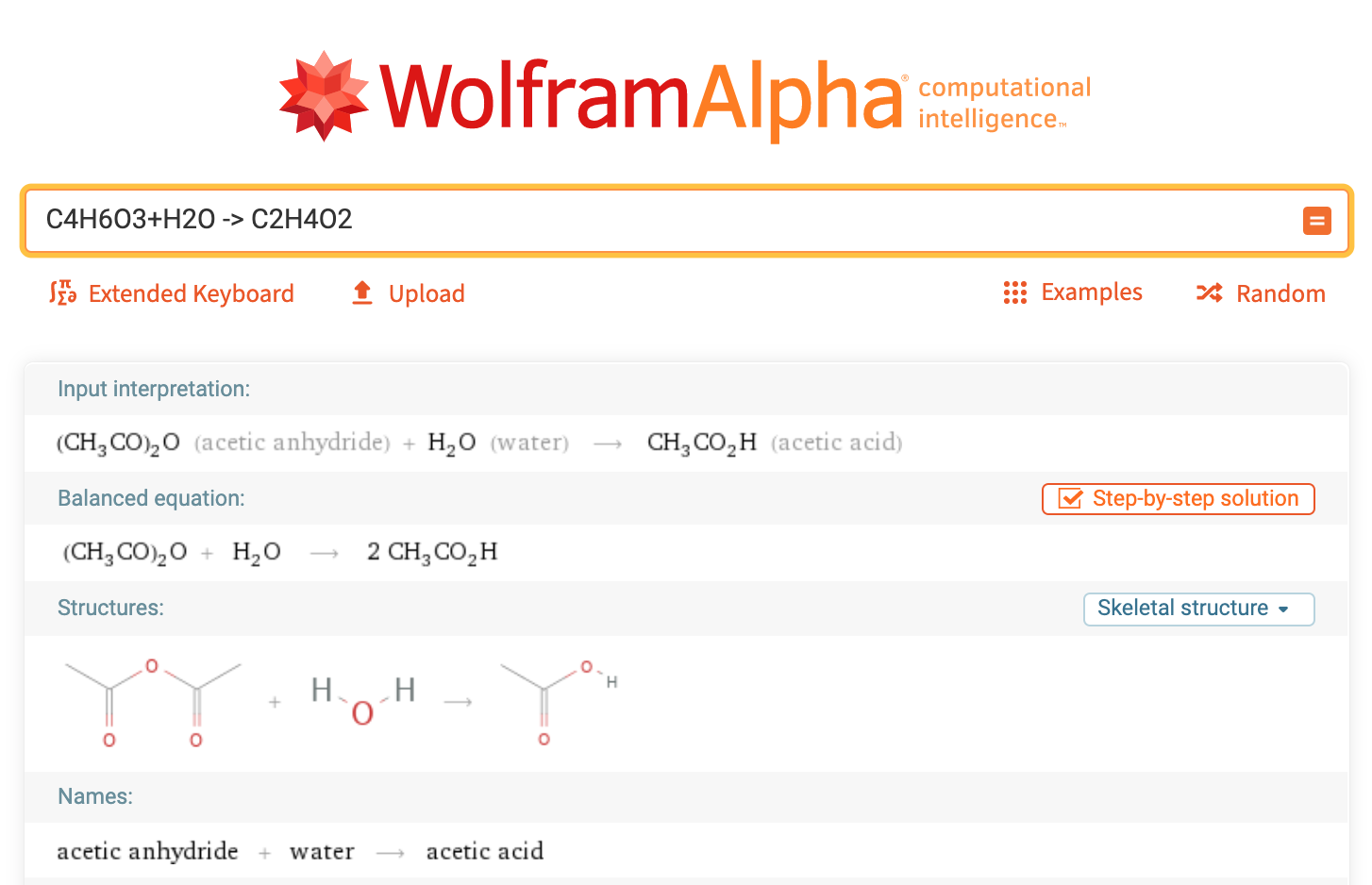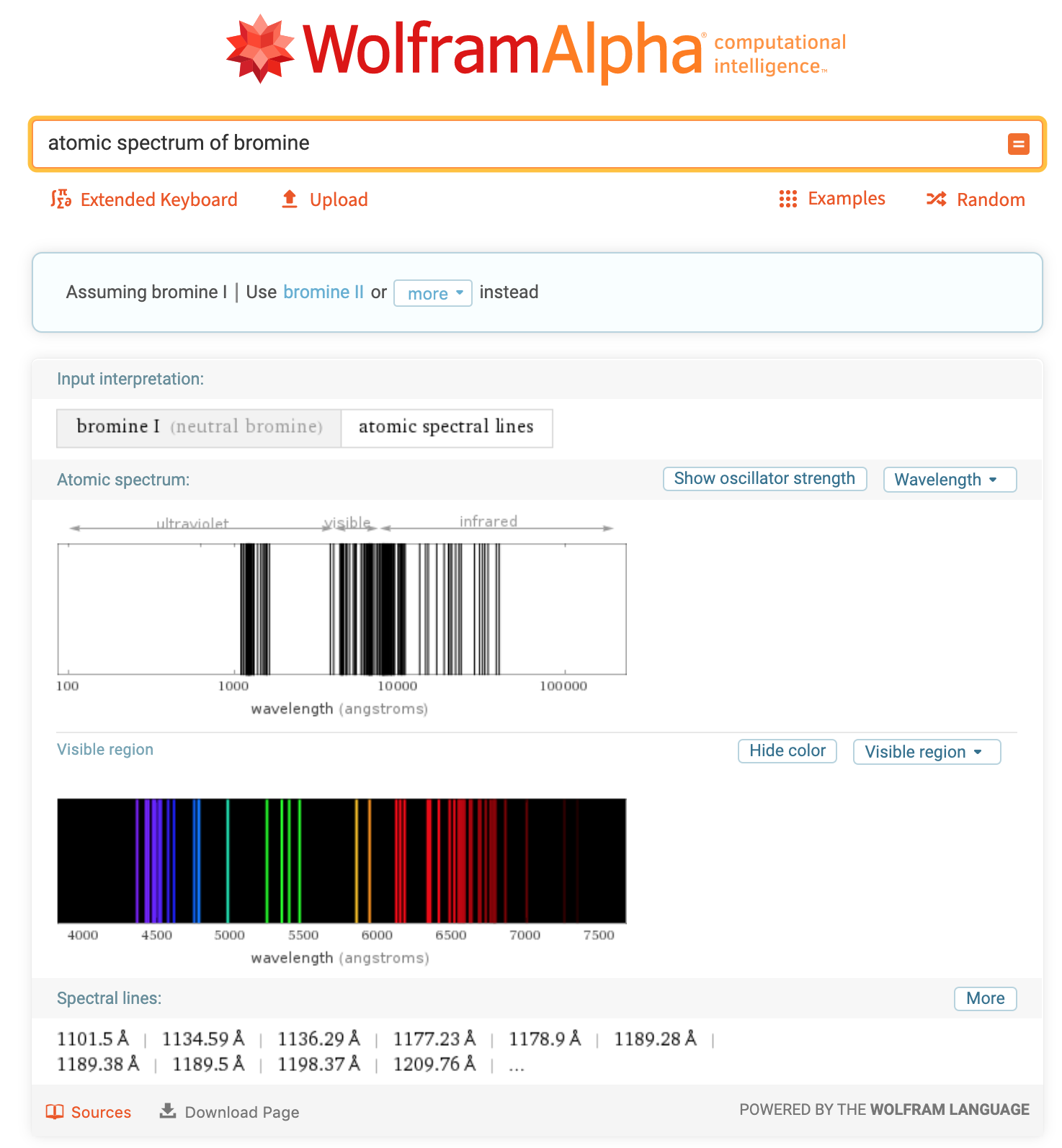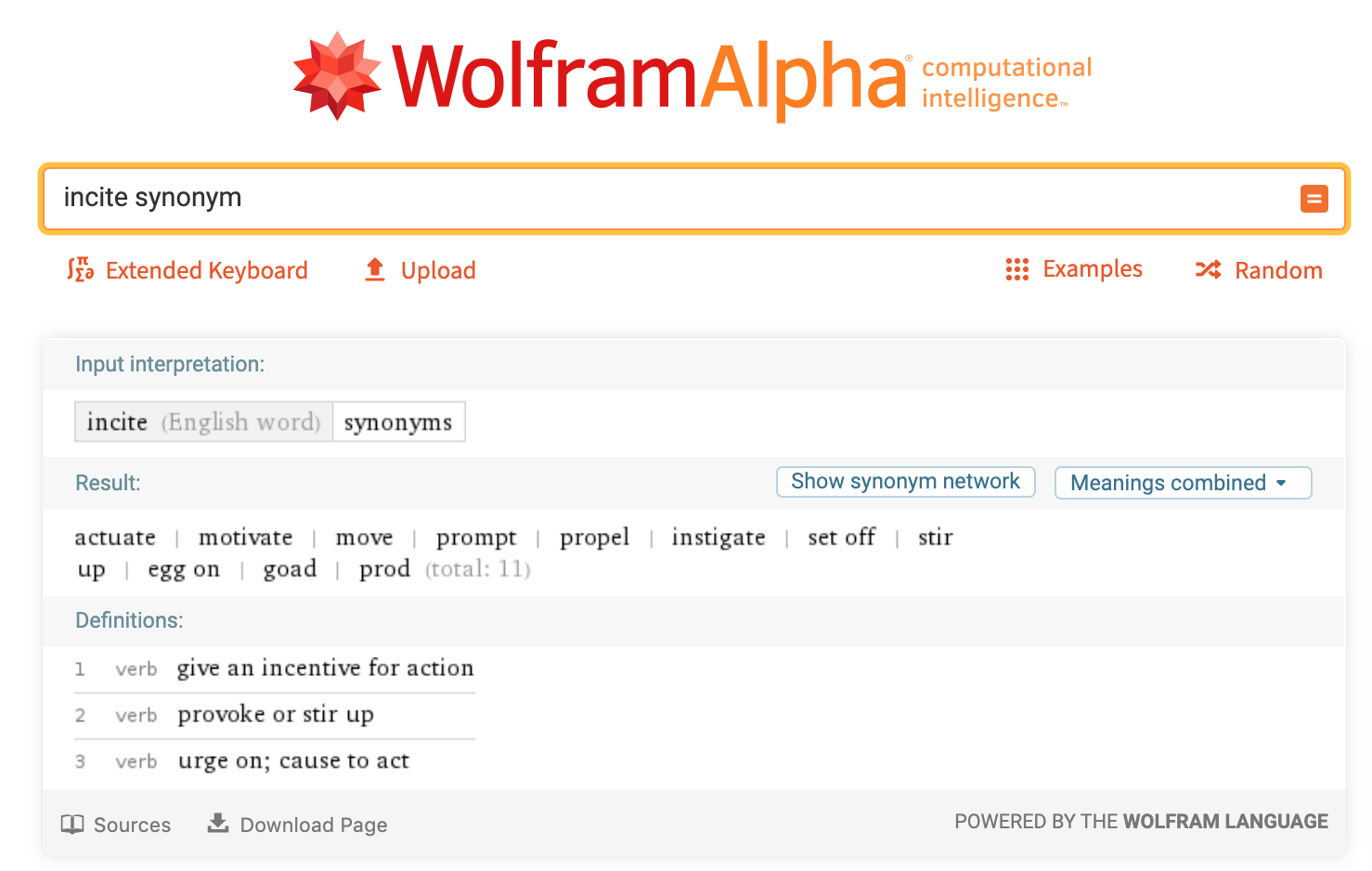15 Ways Wolfram|Alpha Can Help with Your Classes

We all know Wolfram|Alpha is great for solving calculations and math problems, but not everyone knows about the full breadth of useful data it provides. I entered college as a biology major and was quickly overwhelmed with the amount of information I had to memorize. Class lectures moved at a fast pace, and often my notes had gaps in them where I hadn’t finished writing down what the professor was saying before she moved on. I was up late at night making flashcards for tests and searching desperately through Yahoo! Answers, trying to find information like what exactly the alimentary system does (hint: it “functions in food ingestion and digestion; absorption of water and nutrients; secretion of water, acids, enzymes, buffers and salts; waste excretion; and energy storage”—thanks, Wolfram|Alpha!).
Thinking back on those late-night study sessions, I would have saved a lot of time if I had properly used Wolfram|Alpha as a study tool. Because I was a biology major, many of the areas in which I most frequently sought information were related to scientific fields such as chemistry, but Wolfram|Alpha can be a valuable resource in so many more areas. Here are 15 applications of Wolfram|Alpha in topics beyond mathematics. I hope you will find these to be useful both inside and outside the classroom!
1. Reaction Stoichiometry
Stoichiometry was for me one of the hardest parts of chemistry classes, and I’m sure I’m not alone. Thankfully, Wolfram|Alpha can also calculate stoichiometric problems—finding the amount of a substance needed to complete a reaction as well as the theoretical yields. To calculate a reaction’s stoichiometry, enter the reaction as well as the amounts you know.
For example, let’s use the reaction B2H6 + O2 → B2O3 + H2O. I have 36.1g B2H6 and I need to calculate how many grams of O2 would be necessary to burn all 36.1g of B2H6. In this case, I just enter the following:
36.1 g B2H6 + O2 -> B2O3 + H2O
Wolfram|Alpha balances the equation and calculates the answer, which is displayed conveniently in a table. From this, I now know that I would need 3.914 moles of O2, or 125.2 grams, to burn all of the B2H6:
2. Historical Events and Figures
A great place to find basic information about a significant historical figure or event is Wolfram|Alpha. One thing I find especially helpful is information about specific battles or conflicts. Often, when reading about these events, the scale of them seems so large that I get lost and can’t fully comprehend the important details.
However, Wolfram|Alpha provides only the most important information in easy-to-understand charts that compare both sides, so I’m able to get the full picture succinctly, without spending hours combing through long Wikipedia articles.
For example, I queried “Spanish Conquest of Peru”, the decades-long war between the Kingdom of Spain and the Inca Empire in the 16th century.
Wolfram|Alpha first provides information such as the dates and location, then delves into more specific data, such as the two factions in the conflict, the commanders of both factions, the casualties and losses of both sides, and the major outcomes of the battle.
With this, I can easily understand the basics of what happened without getting bogged down by details.
3. Animals and Plants
Taxonomical information for all manner of organisms is available in Wolfram|Alpha. You can type in a specific organism to find information about it, or you can try a whole species, family, genus or more.
If I enter in something broad and basic, for example “cnidaria”, I come up with a broad range of information, including biological properties, metabolism, other members of the kingdom and phylum, and more.
However, if I don’t want to go through all that data, I can narrow the scope. For example, if I specifically query “planarian taxonomy”, I get a table with the kingdom, phylum, class, order and family all classified:
The breadth of biological data Wolfram|Alpha has available isn’t limited simply to animals. In addition to taxonomical and basic information, Wolfram|Alpha can generate growth curves for plants for specific locations and compare them to the American national average. For example, if I query “maple tree growth curve in Illinois”, I get a graph of the growth curve of maple trees in Illinois, a graph of the growth curve for the entire USA and a chart detailing the taxonomical information of a maple tree:
4. Balancing Equations/Converting to Moles
Wolfram|Alpha can balance chemical equations as well. For example, I used the query “C4H6O3+H2O -> C2H4O2”. Wolfram|Alpha first shows you the answer, then the structure of the equation. What’s particularly helpful about this is you can toggle the type of structure you want to look at—you can switch from a skeletal structure to a Lewis structure, or display all the atoms.
Scroll down further and you’ll find Wolfram|Alpha displays the chemical names and formulas of the components involved, as well as other relevant information such as their molar masses, densities, melting points and more.
Similarly, converting mass or volume to moles and vice versa with Wolfram|Alpha is really simple. Just type in the amount of a substance in moles or mass along with the unit to which you want it converted (for example, 7 moles of acetic acid to kilograms), and Wolfram|Alpha computes the answer along with other possible unit conversions and corresponding quantities:
5. Anatomical Information
Wolfram|Alpha has extensive anatomical and medical information available freely at your fingertips. For example, if you query “human heart arteries”, the results interpret this query correctly as the left and right coronary arteries, then display their Latin names, alternate names and a brief description of the function of each artery:
If you scroll further down, models of the morphologies, regional locations and body locations are also displayed:
Beneath that are the physical characteristics, constitutional parts and connections (how the arteries function as part of the circulatory system):
You can also contrast and compare more specific aspects of two different structures—for example, “function of gallbladder vs liver”:
The range of information available isn’t limited to only humans. All creatures great and small are represented in a similar way as the human data. Try the query “horse femur”, for example. The first thing displayed is the hierarchical relationships of the left and right femurs, followed by models of the morphology, regional location and body location:
Finally, even the articulations and homologous structures are shown:
6. Genomics
I found that you can even analyze a gene with Wolfram|Alpha—and not just from the human genome. Wolfram|Alpha has data from the fully sequenced genomes of the mouse, the fruit fly and more.
Let’s take a look at the results for the query “human gene gfra1”. First, Wolfram|Alpha interprets the query, then provides the standard and alternate names, and then the location of the gene via a table chart as well as a visual representation of its location on chromosome 10:
Wolfram|Alpha also displays other relevant information such as the reference sequence, other nearby genes, visual representations of gene-splicing structures, protein names and more. It also provides gene ontology characteristics such as functions and processes.
Apart from genes, information on proteins and biomolecules is also available. In the case of proteins, such as hemoglobin, Wolfram|Alpha provides the sequence, molecular weight and models of the ribbon and atomic structures. For biomolecules like serotonin, the chemical names and formula are displayed, as well as a structure diagram:
7. Atomic Spectrum
If you’re working with atomic spectra, Wolfram|Alpha is a great resource to have. If you enter in “atomic spectrum of” plus whatever element you’re working with, Wolfram|Alpha will display a visualization of the atomic spectrum and the visible regions. It also includes the spectral lines. What’s particularly handy is that for the visualization of the atomic spectrum, you can toggle among wavelength, frequency and energy. Next to the toggle is the option to show or hide additional views, like oscillator strength and color.
8. Writing
When not bogged down by schoolwork (which is admittedly rare), I like to read and write, and have found Wolfram|Alpha to be a surprisingly helpful resource. In addition to providing definitions and translations of words, Wolfram|Alpha can give synonyms, antonyms, words that rhyme with a specific word and more.
The main reason I prefer using Wolfram|Alpha to find definitions rather than the more popular dictionary or thesaurus sites is because there’s so much more interesting information provided on Wolfram|Alpha. For example, if I query the word “fugue”, I get not only three different definitions, but also the word’s first known usage in English, its roots, a timeline of its usage, a list of translations into other languages, a list of broader terms with the same or similar meanings and more.
You can also discover synonyms or antonyms of a word with Wolfram|Alpha. If I type in the query “incite synonym”, Wolfram|Alpha generates a list of synonyms, and also provides definitions below.
In addition to synonyms and antonyms, Wolfram|Alpha can also list words that rhyme with a certain word. For example, if I enter in “words that rhyme with sublime”, I get a list of words such as lime, dime, prime, etc. This feature could be especially useful to poets, songwriters and other creative writers.
Another feature writers and readers alike can appreciate is that Wolfram|Alpha can provide relevant quantitative data relative to the number or words or pages of a document. For example, if I type in “12,000 words”, Wolfram|Alpha can tell me how many pages that document would be; how long it would take to read, write or speak it; and more.
Got a secret message you need to pass on? Wolfram|Alpha can help with that too. Apart from translating words and phrases from one language to another, Wolfram|Alpha can also convert words and phrases into Morse code. Just type what you want to translate and let Wolfram|Alpha do the rest.
9. Kinematics
When working with kinematics, Wolfram|Alpha is a great tool to have in your figurative belt. If you’re doing a two-body collision problem, for example an elastic collision, Wolfram|Alpha can compute the final speeds of the two bodies as well as generate a useful schematic that visualizes the collision. Simply type in “elastic collision” plus the values for the initial mass and velocities of the two bodies and press Enter. The first thing Wolfram|Alpha does is interpret the input information, displaying it in a chart. It then calculates the result for the two final speeds, then generates a schematic visualizing the collision.
10. Cognition
In addition to having detailed information on brain anatomy, as in previously shown examples, Wolfram|Alpha also carries a good deal of information on cognitive tasks and related areas such as memory, language, attention, reasoning and perception tests.
You can also find information on individual types of neurons in the nervous system. Along with the location and description of a neuron, Wolfram|Alpha also includes useful data such as its synaptic properties and electrophysiological measurements:
Similarly, you can also look for brain areas by criteria like their functions. For example, querying “brain area associated with memory” brings up a list of associated brain areas, with each result listed linking to a separate page for that specific brain area.
11. Socioeconomic Data
Researching country-specific socioeconomic data is very simple. Type in what you want to know, followed by the country. If you are comparing several countries, separate the names with a comma. For example, try querying “GDP of Mozambique, Namibia, Mali” or like in this example, “unemployment rate Vietnam, Cambodia, Laos”.
The first thing Wolfram|Alpha displays is the interpretation of your input, followed by the direct results:
It then displays other relevant information, such as the unemployment rates for the three countries over time, the long-term unemployment rate (separated by sex), the unemployment rate by education, labor force by education and more:
If you want to check the data associated with a particular region of the US, Wolfram|Alpha can be especially helpful. You can find data like income, for example the highest per capita income by county:
12. Titration
Wolfram|Alpha has a great tool for calculating titrations. It can compute for the volume of base, volume of acid, base concentration or acid concentration. All you need to do is plug in the corresponding variables, such as volume or concentration of base, etc. Wolfram|Alpha then computes the answer.
13. Quantum Mechanics
Wolfram|Alpha can be a helpful resource for looking up and comparing equations. For example, if you enter in “particle in a box”, a model fundamental to the field of quantum mechanics, the input results first show an interpretation of your query, followed by all the relevant equations for both classic and quantum mechanics. Wolfram|Alpha also displays a diagram of the potential energy.
14. Hybridization in a Compound
Hybridization, or the mixing of atomic orbitals on an atomic center, is pretty hard to get the hang of. Wolfram|Alpha comes through as a great resource in this regard. Simply enter the name of the chemical compound plus “hybridization” and Wolfram|Alpha will display the hybridization on each atom in the molecule, the electron count and a diagram with the orbitals labeled:
Similarly, Wolfram|Alpha also has information about each of the bonds in a compound. If you type in the compound name plus “bonds” or “bond information”, Wolfram|Alpha will provide you with a convenient chart with each of the bonds, their bond count, bond length and energy in kJ/mol (although you can adjust the units if need be):
15. Thermodynamics
Calculating thermodynamics problems such as isothermal processes is made simple with Wolfram|Alpha. If you query “isothermal process”, a calculator tool with input tools for initial pressure, initial volume, initial temperature and final volume appears. Input the values corresponding to your needed calculation, press Compute and a table with the results for final pressure, entropy change, heat transferred to the system, final temperature and work done on the system is generated. Wolfram|Alpha also generates graphs of pressure vs. volume and temperature vs. entropy.
While I found these 15 applications of Wolfram|Alpha technology useful, my list only scratches the surface; Wolfram|Alpha has so much information and functionality to offer on subjects ranging from radioactive decay to classical mythology, to comparing nutrition information in a meal, calculating Bose–Einstein distributions, estimating how many of an object would fill a container, computing the luminosity of a star and many more. Whether you’re a student preparing for an upcoming exam or just a curious individual interested in researching a particular topic (perhaps the physics of running in the rain!), I highly recommend Wolfram|Alpha as an informational resource. It has a lot more to offer than just math-related information and solutions!






































Comments